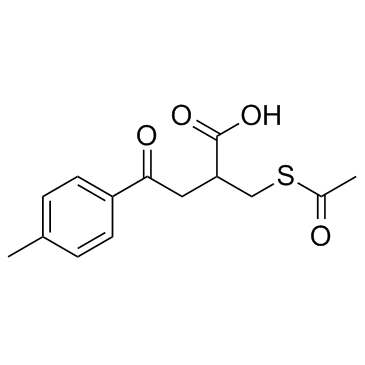| Description |
Esonarimod is an antirheumatic drug.
|
| Related Catalog |
|
| In Vitro |
Esonarimod (KE-298) (10 to 300 μg/mL) suppresses the production of NO by RAW264.7 cells in a dose dependent manner. The IC50 of Esonarimod is 117.5 μg/mL. Esonarimod does not affect cellular viability at these tested doses. Esonarimod has no direct effect on NOS activity in cell-free extracts of RAW264.7 cells[1].
|
| In Vivo |
After repeated oral administration of Esonarimod (14C-KE-298), the radioactivity decreases rapidly and no tendency towards accumulation is found[2].
|
| Kinase Assay |
Enzyme activity of NOS is determined using an assay kit for NOS activity. Briefly, the lysate from RAW264.7 cells (a protein concentration of 37.5 μg/200 μL) is incubated for 3 h at 37°C with 100 mM of L-arginine in the presence of Esonarimod (KE-298) and the conversion of L-arginine to nitrite is monitored. The nitrite generated in the reaction mixture is assayed using Griess reagent[1].
|
| Cell Assay |
RAW264.7 cells are used in this study. For NO production, RAW264.7 cells [2×105/0.2 mL of RPMI-1640 supplemented by 10% heat inactivated fetal bovine serum (FBS), penicillin G (100 U/mL), and streptomycin (100 μg/mL)] are stimulated with 100 ng/mL of Escherichia coli 026:B6 lipopolysaccharide in the presence of Esonarimod (KE-298) (0, 10, 30, 100, 200, 300 μg/mL) in 96 well plates and incubated 24 h at 37°C in an atmosphere of 5% CO2 in air. After incubation, the supernatants are collected and assayed for nitrite (NO2-) instead of NO[1].
|
| Animal Admin |
Seven-week-old male Wistar rats are used in this study. The animals are fasted overnight before dosing and for up to 4 h after dosing, except for the study on tissue distribution after repeated oral administration. The rats are grouped, three or four rats per group. Esonarimod (14C-KE-298) is administered orally by gastric intubation in a dose of 5 mg/kg once daily for 21 days. At 20 min, 24 h or 21 days after dosing with Esonarimod, the rats are anaesthetized with ether and blood samples are collected from the femoral aorta into heparinized containers. The liver, kidney, lung, aorta and skin are excised and weighed. Tissues (except aorta) are homogenized with ice-cold physiological saline to yield a 20% homogenate[2].
|
| References |
[1]. Inoue T, et al. KE-298 and its active metabolite KE-758 suppress nitric oxide production by murine macrophage cells and peritoneal cells from rats with adjuvant induced arthritis. J Rheumatol. 2001 Jun;28(6):1229-37. [2]. Hasegawa M, et al. Formation of a disulfide protein conjugate of the SH-group-containing metabolite (M-I) ofesonarimod (KE-298) and its elimination in rats. J Pharm Pharmacol. 2002 Apr;54(4):493-8.
|
